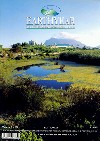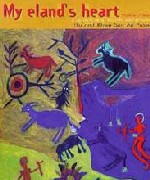Trailing the Schmidtsdrift San
Barbara Ludman
19 August 2003
The path winds over the koppie, past blackthorn and umbrella thorn, camel and buffalo thorn, low-lying shrubs hunched against the wind. Red anthills dot the landscape, and somewhere, though never seen, are the aardwolf and aardvark that feed on their occupants.
'Vapour trails' of time rise - Only in Mpumalanga will you find these images of humans with curving tails like streamers, nesting one inside the other. 
|
|
The rock art trail at Wildebeest Kuil runs through stark and beautiful country, just 15km from Kimberley. There are lookout points along
the track, and from some of them visitors can see the town on the horizon.
You can walk at your own pace on a self-guided tour. The trail and recorded commentary lead you through the history of the area and the people who lived there, the importance of the wind, the remains of a stone kraal and an ash heap, to an elevated boardwalk.
On piles of andesite rocks jumbled together just off the boardwalk are engravings made between 1 000 and 2 000 years ago - elephant, antelope, rhino, wildebeest, many eland, dancing human figures, geometric designs - chiselled with a hard pointed stone by artists of exceptional talent.
Some of the engravings are partial figures that seem to rise out of the rock - suggesting, according to the authors of Fragile Heritage, "that the San saw the rock surface as a veil between this world and the spirit world. Is the eland's head intended to look as if it disappears into the spirit world behind the surface of this rock?"
There are more than 150
rock engravings in the Wildebeest Kuil alone, all which have been excellently preserved by the dry bushveld air. The trail at Wildebeest Kuil was opened in December 2001, which makes it one of the newest sites. It's easy to get to - just off the road from Kimberley to Barkly West.
The Schmidstdrift San
But its claim to fame goes beyond the excellence of the engravings and the ease of access. Its importance is enhanced by its location: on the farm Platfontein, owned by two San communities, the !Xun and the Khwe.
These aren't the direct descendents of the San who chipped out the engravings. In the 1960s, the then-South African Defence Force (SADF) needed trackers for its operations in Namibia and Angola, and recruited the men, sometimes forcefully, sometimes not; and their families followed. A generation of !Xun and Khwe San grew up in army camps, far from their ancestral lands in Angola.
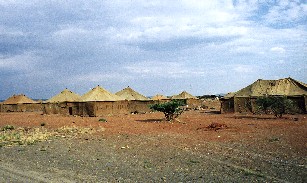 The Schmidtsdrift tent town
The Schmidtsdrift tent town
When Namibia became independent in 1990, the SADF offered its erstwhile trackers sanctuary in a tent town it built for them on a windy plain in Schmidtsdrift in the Northern Cape. Four years later, with the new democratic government, the San believed they would be given security of tenure there, but the land was judged to belong to the BaTlhaping, a Tswana group that had been removed from it decades earlier.
Then the Department of Land Affairs bought the farm Platfontein for the Communal Property Association (CPA), which represents the two San communities. The !Xun and Khwe now own 12 500 hectares of bushveld with hundreds of ancient rock engravings.
The official handover was May 1999, but by that time the Schmidstdrift San had been involved on the farm for some time, moving a craft project from two trailers and a container on Schmidtsdrift to the Platfontein farmhouse.
My Eland's Heart
There, the painters,
potters and woodcarvers of the !Xun and Khwe San Art and Culture Project create art drawn "from a tradition in which creativity was a natural part of life", writes Marlene Sullivan Winberg in the copiously illustrated My Eland's Heart, a book about the project.
"Many of the men and women ... have said that they derive their particular themes and symbols from the traditional knowledge they received from their parents. The musical instruments made by old people, their jewellery, bows and arrows, and wood carvings are rooted in their ancient culture. Even in new media like oil paintings, textiles and pottery, the symbols and images used often incorporate traditional motifs and stories."
As for the hunters, she quotes 82-year-old artist Joao Wenne Dikuanga: "When I think about this eland inside me, I take a sheet of paper and draw it."
There are elands aplenty in the colourful oils and dramatic lino prints produced at the project, but there are so many other motifs:
illustrations of ancient legends, geometric designs, birds, trees, elephants - many elephants. A haunting work by Madena Kasanga, a former baker, has dancing humanoid dogs surrounded by canines; another shows neat row after row of stylised turquoise huts on an orange background - presumably the Schmidtsdrift she's left behind.
The artists in the project live at Platfontein; so do the rock art guides and the visitors' centre staff. There are jobs at the centre, but they amount to a trickle - and the need is great.
The land has been divided into thirds: one-third residential, one-third as a commercial game farm, and the final third as a commercial cattle farm.
Hennie Swart, manager of the Northern Cape Rock Art Trust and former CEO of the CPA, has helped to set up a job placement agency for short-term work as a form of training. There are, he says, 988 families in the two communities. "If we can create jobs for 500 individuals on Platfontein", he says, "the others can work
outside, as trackers and security people on other farms."
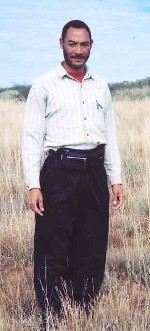 Batista Salvadore: interpreting the language of San rock art. (Photo: Janet King)
Batista Salvadore: interpreting the language of San rock art. (Photo: Janet King)
The first San guide of rock art
Batista Salvadore describes himself as the first San guide of rock art in South Africa - "People thought we had no knowledge to do that kind of thing. In the past, it was only whites or black people - nobody from our community could be a guide for our own paintings." Fluent in !Xun and Khwe as well as English, Portuguese and Afrikaans, he was an interpreter for the CPA until Wildebeest Kuil opened in 2001.
Salvadore guides archaeologists and anthropologists from the United States, the United Kingdom, France, Germany, Japan. The fame of the site is widespread. He's taught a party of Chinese guides who will be bringing visitors to
Kimberley, and heís gone back to Namibia to train guides there.
Still he's not content. "I'm trapped," he says. "By nature the San are travellers. We don't know how to function in this society."
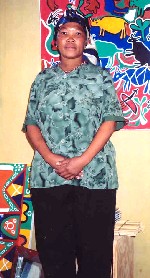 Willemena Calica with some of the artwork on sale at the centre (Photo: Janet King)
Willemena Calica with some of the artwork on sale at the centre (Photo: Janet King)
But there is no going back. Willemena Calica, who works in the centre's tea shop, says she longs to return to a world without fences. But she's already gone beyond the traditional role of a San woman. An orphan, and educated, she chose her own husband - a soldier - and is very happily married. She says she doesn't see why women must have such a hard life, and sees no reason why women must be subservient to men.
So the world is changing for the Schmidtsdrift San - but the culture depicted in the rock engravings they are protecting is timeless.
And with one of the richest rock art areas in the world on their land, the !Xun and the Khwe could be among the lucky ones, able to accommodate - as they have in their art and craft - both the modern world and traditional culture.
This article was first published in Earthyear Magazine, The
Essential Environmental Guide. Volume I, 2003 is now available at CNAs and selected bookstores countrywide. Or visit the Earthyear web site.
 The Schmidtsdrift tent town
When Namibia became independent in 1990, the SADF offered its erstwhile trackers sanctuary in a tent town it built for them on a windy plain in Schmidtsdrift in the Northern Cape. Four years later, with the new democratic government, the San believed they would be given security of tenure there, but the land was judged to belong to the BaTlhaping, a Tswana group that had been removed from it decades earlier.
Then the Department of Land Affairs bought the farm Platfontein for the Communal Property Association (CPA), which represents the two San communities. The !Xun and Khwe now own 12 500 hectares of bushveld with hundreds of ancient rock engravings.
The official handover was May 1999, but by that time the Schmidstdrift San had been involved on the farm for some time, moving a craft project from two trailers and a container on Schmidtsdrift to the Platfontein farmhouse.
My Eland's Heart
There, the painters,
potters and woodcarvers of the !Xun and Khwe San Art and Culture Project create art drawn "from a tradition in which creativity was a natural part of life", writes Marlene Sullivan Winberg in the copiously illustrated My Eland's Heart, a book about the project.
"Many of the men and women ... have said that they derive their particular themes and symbols from the traditional knowledge they received from their parents. The musical instruments made by old people, their jewellery, bows and arrows, and wood carvings are rooted in their ancient culture. Even in new media like oil paintings, textiles and pottery, the symbols and images used often incorporate traditional motifs and stories."
As for the hunters, she quotes 82-year-old artist Joao Wenne Dikuanga: "When I think about this eland inside me, I take a sheet of paper and draw it."
There are elands aplenty in the colourful oils and dramatic lino prints produced at the project, but there are so many other motifs:
illustrations of ancient legends, geometric designs, birds, trees, elephants - many elephants. A haunting work by Madena Kasanga, a former baker, has dancing humanoid dogs surrounded by canines; another shows neat row after row of stylised turquoise huts on an orange background - presumably the Schmidtsdrift she's left behind.
The artists in the project live at Platfontein; so do the rock art guides and the visitors' centre staff. There are jobs at the centre, but they amount to a trickle - and the need is great.
The land has been divided into thirds: one-third residential, one-third as a commercial game farm, and the final third as a commercial cattle farm.
Hennie Swart, manager of the Northern Cape Rock Art Trust and former CEO of the CPA, has helped to set up a job placement agency for short-term work as a form of training. There are, he says, 988 families in the two communities. "If we can create jobs for 500 individuals on Platfontein", he says, "the others can work
outside, as trackers and security people on other farms."
The Schmidtsdrift tent town
When Namibia became independent in 1990, the SADF offered its erstwhile trackers sanctuary in a tent town it built for them on a windy plain in Schmidtsdrift in the Northern Cape. Four years later, with the new democratic government, the San believed they would be given security of tenure there, but the land was judged to belong to the BaTlhaping, a Tswana group that had been removed from it decades earlier.
Then the Department of Land Affairs bought the farm Platfontein for the Communal Property Association (CPA), which represents the two San communities. The !Xun and Khwe now own 12 500 hectares of bushveld with hundreds of ancient rock engravings.
The official handover was May 1999, but by that time the Schmidstdrift San had been involved on the farm for some time, moving a craft project from two trailers and a container on Schmidtsdrift to the Platfontein farmhouse.
My Eland's Heart
There, the painters,
potters and woodcarvers of the !Xun and Khwe San Art and Culture Project create art drawn "from a tradition in which creativity was a natural part of life", writes Marlene Sullivan Winberg in the copiously illustrated My Eland's Heart, a book about the project.
"Many of the men and women ... have said that they derive their particular themes and symbols from the traditional knowledge they received from their parents. The musical instruments made by old people, their jewellery, bows and arrows, and wood carvings are rooted in their ancient culture. Even in new media like oil paintings, textiles and pottery, the symbols and images used often incorporate traditional motifs and stories."
As for the hunters, she quotes 82-year-old artist Joao Wenne Dikuanga: "When I think about this eland inside me, I take a sheet of paper and draw it."
There are elands aplenty in the colourful oils and dramatic lino prints produced at the project, but there are so many other motifs:
illustrations of ancient legends, geometric designs, birds, trees, elephants - many elephants. A haunting work by Madena Kasanga, a former baker, has dancing humanoid dogs surrounded by canines; another shows neat row after row of stylised turquoise huts on an orange background - presumably the Schmidtsdrift she's left behind.
The artists in the project live at Platfontein; so do the rock art guides and the visitors' centre staff. There are jobs at the centre, but they amount to a trickle - and the need is great.
The land has been divided into thirds: one-third residential, one-third as a commercial game farm, and the final third as a commercial cattle farm.
Hennie Swart, manager of the Northern Cape Rock Art Trust and former CEO of the CPA, has helped to set up a job placement agency for short-term work as a form of training. There are, he says, 988 families in the two communities. "If we can create jobs for 500 individuals on Platfontein", he says, "the others can work
outside, as trackers and security people on other farms."
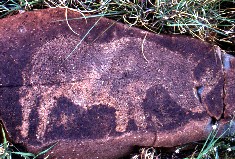 A Wildebeest Kuil rhinoceros engraving dating back between 1 000 and 2 000 years
A Wildebeest Kuil rhinoceros engraving dating back between 1 000 and 2 000 years
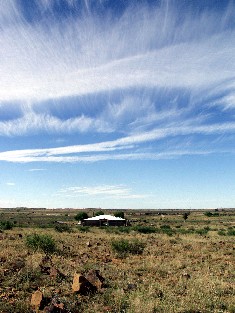 Big sky country ... the Wildebees Kuil landscape is a botanistís delight. See Tania Anderson's description below.
Big sky country ... the Wildebees Kuil landscape is a botanistís delight. See Tania Anderson's description below.




 Batista Salvadore: interpreting the language of San rock art. (Photo: Janet King)
Batista Salvadore: interpreting the language of San rock art. (Photo: Janet King)
 Willemena Calica with some of the artwork on sale at the centre (Photo: Janet King)
Willemena Calica with some of the artwork on sale at the centre (Photo: Janet King)
